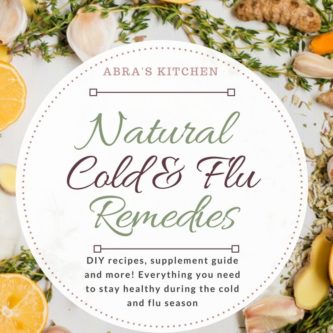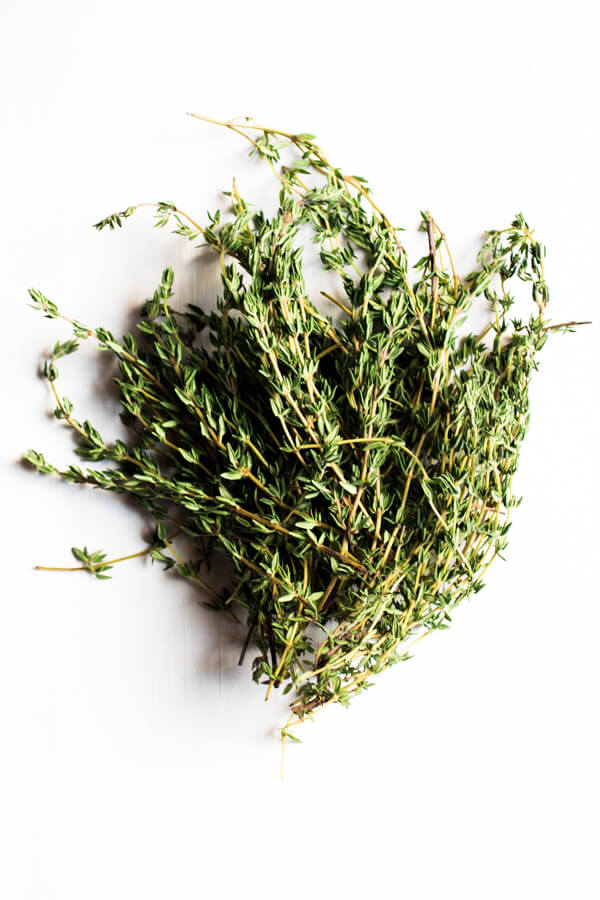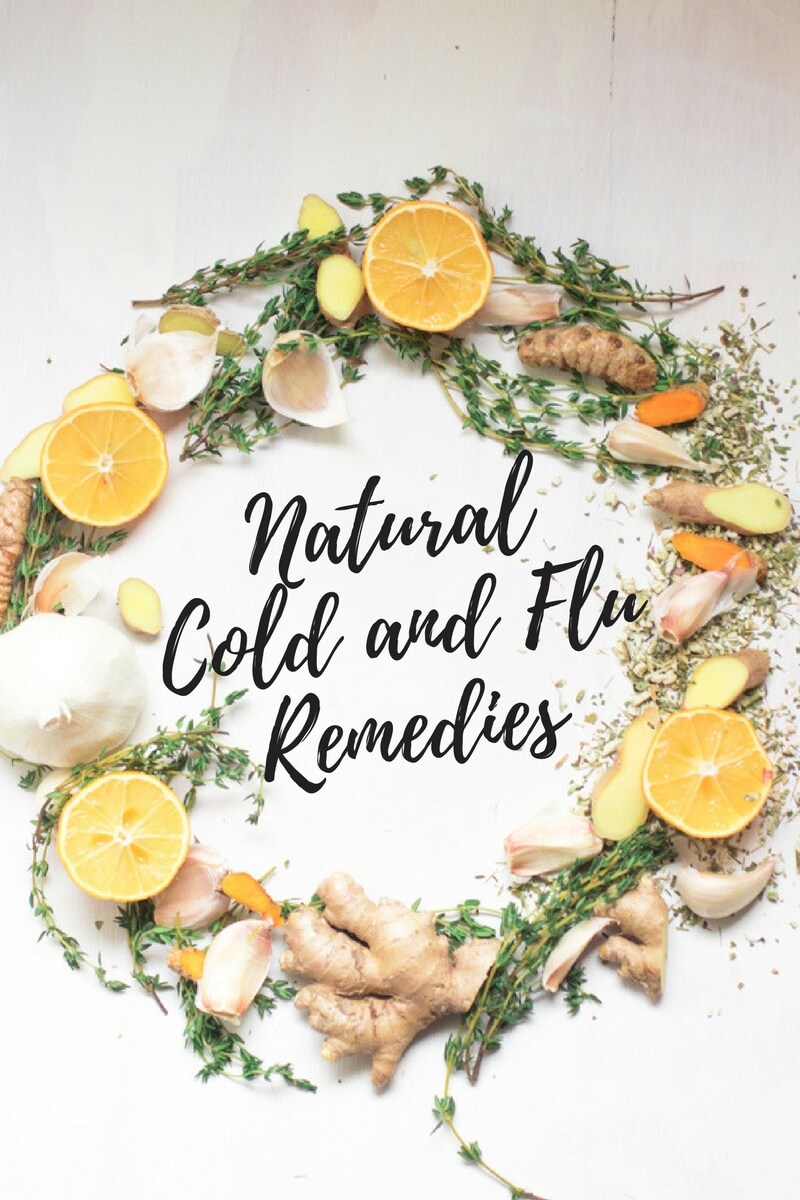
A comprehensive guide on Natural Remedies for Cold and Flu including peer-reviewed literature on the efficacy of each treatment. DIY recipes, natural treatments, and easy to follow instructions to keep you healthy and strong during the cold and flu season
Tis the season, my friends, everyone is sick! Headlines read: “The Flu Season is the Worst in Decades”, “Flu Epidemic Intensifies!” New Yorkers are sporting the ever sexy medical mask fashion, and media is urging all of us to RUN to the nearest pharmacy for your flu shot.
The flu shot is not for me, for many reasons which I choose not to address in this post, but here is a great article that breaks that down a little from Dr. Kara Fitzgerald:
“The flu vaccine continues to be inadequate, and yet we put all of our medical eggs into this basket. Even in its best years, it may be about 60% effective. This year, it’s estimated that vaccine efficacy may be a woeful 10%.”
The vaccine effectiveness varies greatly depending on the influenza type or subtype. Even if you did get the flu shot you could be one of the thousands that still gets sick.
Going the natural route when it comes to both prevention and treatment feels normal to me. It may not to you, and that's totally ok. My mom used natural remedies for my entire childhood and for a family of 6 we were rarely, to never, sick. I took my first antibiotic in my 20's for a root canal. I am convinced my immune system is much stronger for it.
My hope is that you will walk away from this post with a few helpful tips and tools to feel more empowered when illness strikes.
By all means, do what's right for you and please consult your physician, this post is by no means meant to be a replacement for medical care.
Natural Remedies vs. Over the Counter Medications
You will have to make your choice here, but I will say this. It is my belief that OTC medications can help with symptoms, which in turn can sometimes help shorten the duration of an illness. They also come with side effects.
If you are a parent it is worth mentioning that according to the FDA website:
“Most young children with a cough or cold do not need OTC medicine” The FDA also states that OTC cough and cold medicines are not effective for children under two, and can be potentially dangerous.Manufactures also voluntarily re-labeled these cough and cold products to state: “do not use in children under 4 years of age.” Some advocacy groups are campaigning to have OTC medication labeled for children 11 years of age and older.
Everything mentioned in this post is safe for children (it's all food people!). Let's get to it!
At The First Sign of Illness Take
(Norm's Farms generously provided product for this post, the opinions are my own)
At the first sign of illness, chills, sniffles, just a general feeling of being unwell. You know that feeling the, “uh -oh, I'm coming down with something” feeling. This is when you have to seriously step into action.
1. Elderberry Extract
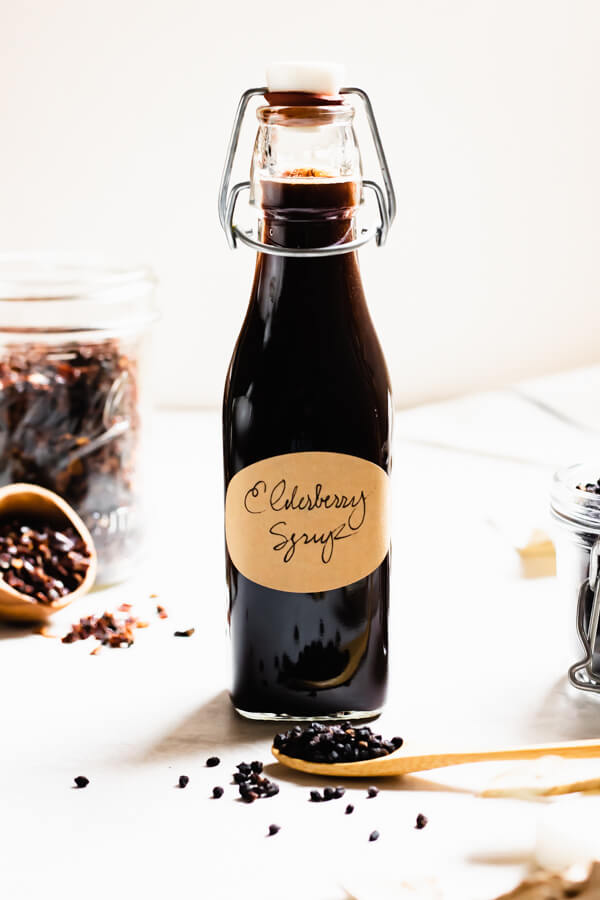
Black elderberries (sambucus nigra L.) are well known, and well studied, agents against the common cold and influenza virus. Hippocrates referred to the elder tree (gifting us with both potent elderberries and elderflowers) as his medicine chest.
So ya know, if it's good for Hippocrates, it's probably good for you too.
Elderberries are a rich source of vitamin C and anthocyanins and possess strong antimicrobial activity against both Gram-positive bacteria and Gram-negative bacteria. This means it is an effective agent against human pathogenic bacteria as well as influenza viruses. Elderberries have also been shown to have an inhibitory effect on the propagation of the influenza virus.
In other words, elderberries can both prevent the flu and reduce the duration of the flu by inhibiting the replication of the flu virus.
This stuff is potent.
I make homemade elderberry syrup, it is surprisingly easy and one of my favorite projects in early fall.
You can also check out my elderberry thumbprint cookie recipe because sometimes a cookie + flu prevention is kind of dope.
If you are a nutrition nerd (like me!) I included 3 more elderberry studies below including a really cool one that showed a significant reduction of cold duration and severity in air travelers using elderberry extract.
Dosage: I follow(ish) the dosage of, about 1-2 tbsp per day. If I am feeling extra wonky I will take more.

2. Garlic Candy

Garlic has powerful immune-supportive properties. Specifically raw garlic. Consuming raw garlic isn't appealing or easy, but I've got you covered. Welcome to the world of garlic candy!
Benefits of Garlic
In vitro and cell culture studies showed garlic to have antibacterial, antivirus, antifungal, and antiparasitic properties. It is effective at fighting both pathogenic bacteria and harmful microbes including viruses. For this sole reason in some studies, it has been shown to outperform antibiotics for non-life threatening infections and illness. Recently, garlic has been suggested as a promising candidate for maintaining the homeostasis of the immune system. Garlic's antiviral actions include the human rhinovirus, cytomegalovirus, herpes simplex, and influenza.
Garlic has been shown to stimulate activation of the humoral and inert immune system, including the activation of macrophages by NO production and T and B cell production.
Clinical trials have shown garlic to have a beneficial effect in the prevention, duration, and severity of upper respiratory infections.
Garlic ear drops have been shown to be more effective than antibiotic treatment for an ear infection, according to this study.
I could go on and on, but I think you catch the drift. All this without side effects, I may add. Aside from the obvious side effect of perhaps some funky breath 🙂
This recipe for garlic candy was taught to me by an herbalist, many many years ago. It has become a staple in my kitchen during the entire cold and flu season. All you really need to know is this: it works. It seriously works. At the first sign of illness, or if I am around other people that are sick, I will eat 2-3 cloves of garlic per day. I have successfully used this independent of all other recipes/DIY/suggestions in this post. Garlic is my #1 BFF when it comes to prevention and reducing the duration of illness.
It does take a few weeks to ferment, so if it's too late for you this year (it's not. I eat this garlic all the way through spring) be sure to PIN THIS so you remember to make it next fall!
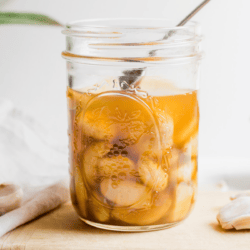
3. Flu Fighter Tea
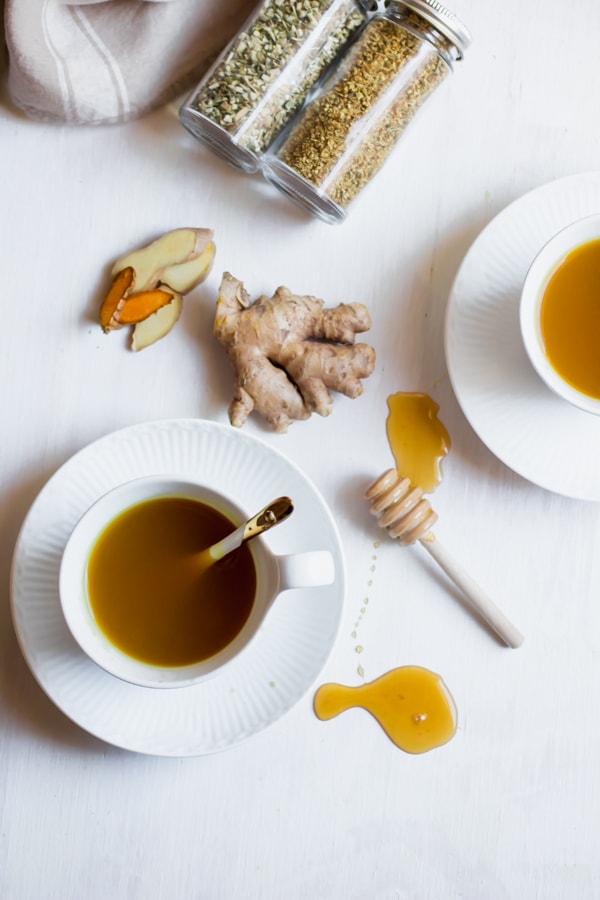
This tea has some serious fighting power thanks to the following potent cold and flu heavyweights:
Echinacea – A perennial plant indigenous to North America. Echinacea is typically taken in tea form or as a supplement. Studies have shown that echinacea reduces the severity of cold and flu and decreases the time you have it. This comprehensive meta-analysis concluded that in sixteen trials (eight prevention trials, and eight trials on treatment of upper respiratory tract infections) with a total of 3396 participants, that some Echinacea preparations may be better than placebo. Echinacea acts like a powerful shield blocking harmful bacteria from gaining access to healthy cells. Unlike antibiotics which directly attack bacteria, echinacea makes our own immune cells more efficient. Evidence indicates that echinacea potently lowers the risk of recurrent respiratory infections and complications thereof. Immune modulatory, antiviral, and anti-inflammatory effects might contribute to the observed clinical benefits, which appear strongest in susceptible individuals. I buy dried echinacea in bulk here.
Elderflower – Elderflower has been used medicinally for centuries to aid in swollen sinuses (sinusitis), colds, influenza (flu), swine flu, bronchitis, diabetes, and constipation. This study which studied elderflower as a potential functional food in the management of diabetes found that most of the phenolic constituents and several of the metabolites showed high antioxidant activity. This antioxidant activity is purportedly what makes elderflower an excellent tool for our cold and flu arsenal. I buy dried elderflower from Norm's Farm (don't forget your 20% off code: “abraskitchen”)
This study which analyzed the antioxidant power (FRAP) assays revealed that the teas prepared from flowers had higher mean 2,2-diphenyl-1-picrylhydrazyl (DPPH) and FRAP activities than the teas prepared from berries. Therefore, elder beverages could be important dietary sources of natural antioxidants that contribute to the prevention of diseases caused by oxidative stress.
Turmeric – Potent anti-inflammatory effect (read all about it here)
Ginger – Antimicrobial and anti-inflammatory. In addition to treating cold and flu, ginger is excellent for nausea and vomiting. Ginger has also exhibited therapeutic antibacterial activity against respiratory pathogens (study).
Cinnamon – Has exhibited antiviral activity against various influenza viruses and has been shown to reduce inflammation.
Clove – Has been used traditionally to ease the pain of toothaches due to its anesthetic properties. Clove can also be used to soothe a sore throat.
Cayenne – Increases circulation and supports bringing heat to the body, which can help dispel coldness.
Lemon – High in vitamin C.
Buckwheat Honey – Increases serum antioxidant capacity (study). One study investigated the use of buckwheat honey as a treatment for nighttime coughs in children due to respiratory infections, like colds. The study found that buckwheat honey was more effective than over-the-counter cough medicine.
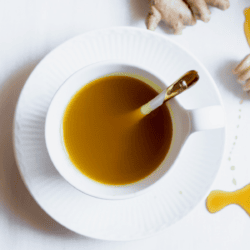
I Got Sick. Now What?
1. Thyme Steam

Thyme acts as an expectorant, loosening phlegm in the respiratory tract so it can be coughed up. Thymol, thymes active ingredient, has strong antibacterial, antimicrobial, and antiseptic properties (study).
This is another trick taught to me by an herbalist and it works! It couldn't be simpler.
Instructions:
Add thyme to a medium-size pot. Cover with water by about 2-3 inches. Stir well and cover. Remove the lid, make sure the steam isn't too hot, and lean over the pot. Cover your head with a towel to create a little tent. Breathe deeply for 5-10 minutes.
If preparing steam for children (this is an EXCELLENT way to help kids get all of that phlegm out, especially if they are young enough that blowing their nose is challenging), I don't recommend the tenting method. Simply place the pot near where they are playing (while supervised please) and allow them to breathe in the air.
Thyme and Buckwheat Cough Syrup
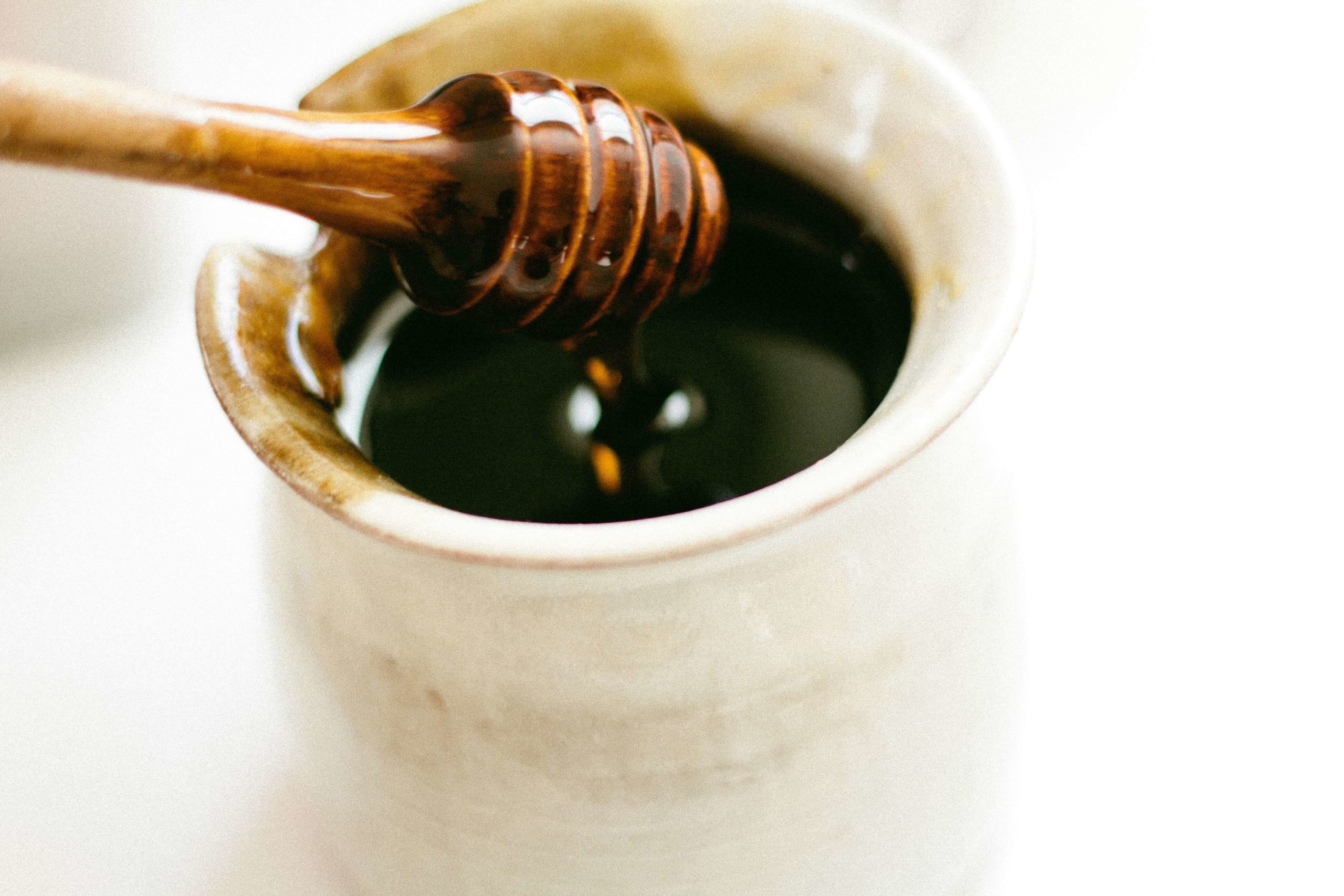
Using the benefits of both thyme and buckwheat honey you can simply whip up a homemade, all-natural, DIY cough syrup.
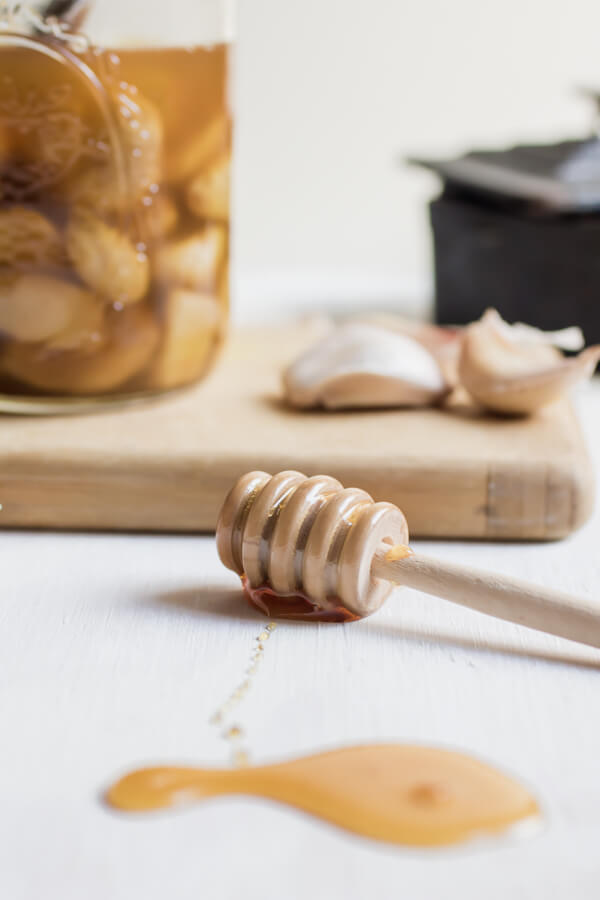
DIY Thyme and Buckwheat Honey Cough Syrup
Ingredients
- 1 bunch fresh thyme
- 1 organic lemon *see notes
- 1/2 cup buckwheat honey
Instructions
- Place fresh thyme in a small pot, cover with water. Bring to a boil and reduce by half.
- In the meantime chop your lemon into 8 pieces and add to a mason jar. Pour honey on top and using the back of a wooden spoon macerate (read: smoosh) the lemon with the honey.
- Pour the reduced thyme liquid on top of the lemon and honey. Replace the lid of the mason jar and shake well to combine.
- Store in your refrigerator for about a month.
- Dosage: Use a spoonful as needed*typically I will take several spoonfuls per day when feeling a sore throat (it tastes amazing!)
Notes
- Organic is important here because you are using the potent lemon oil found in the skin. If you use a conventional lemon you will be adding yucky pesticides to your cough syrup.
3. Fire Immunity Shot
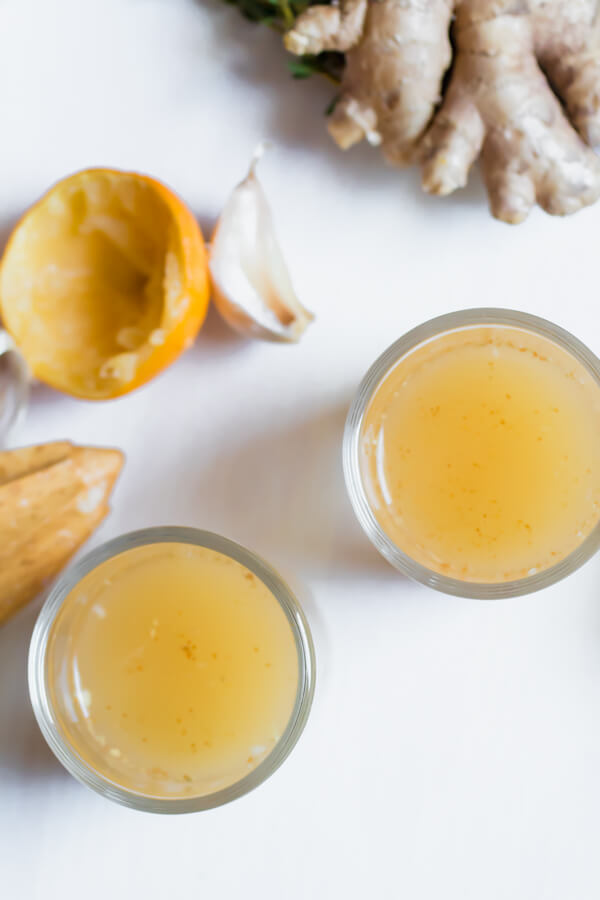
This is a quick version of the beloved fire cider, revered by herbalists for its ability to prevent cold and flu and reduce symptoms.
For the full fire cider recipe download my cold and flu ebook below (it's a freebie).
For the quick version follow the recipe below.
Side note: This is my favorite recipe to sample at my corporate cold and flu prevention event. This past November, offices all over Manhattan were filled with garlic breath employees, this brings me immense joy!

Fire Cider Immunity Shot
Ingredients
- 1 clove garlic, crushed
- 1/4 tsp fresh ginger, grated
- 1/2 lemon, juiced
- 2 tbsp apple cider vinegar
- pinch cayenne pepper
Instructions
- Whisk together all ingredients and throw it back!
A Few Favorite Supplements
1. Probiotic – 80% of your immune system resides in your gut. You should be taking a probiotic daily. Which one depends on many factors (probiotics are strain specific meaning different strains for different conditions) as a generally good probiotic for immune health Prosynbiotic is my choice.
2. Vitamin D – Is essential for good immune health. The hormonal form of vitamin D up-regulates anti-microbial peptides to enhance clearance of bacteria at various barrier sites and in immune cells. Vitamin D modulates the adaptive immune system by direct effects on T cell activation and on the phenotype and function of antigen-presenting cells (APCs), particularly of DCs (study). I like Pure Encapsulations and Designs for Health liquid D3 formula.
3. Omega 3/ Cod Liver Oil – For anti-inflammatory effects. Cod Liver Oil has also been shown to reduce upper respiratory tract pediatric visits in young children (study). This is my favorite cod liver oil (myself and my pup take this one every day).
More Feel Better Tips
- If you are sick, slow down! Get more sleep, cuddle up, stay under warm blankets and take care of yourself. I feel like we have lost the innate sense of how to behave when we are sick. Do not go to work, do not go to the gym (my biggest pet peeve) stay home. If I could speak directly to all the bosses in the world for a minute: encourage your employees to stay home when they are sick, your ENTIRE company will benefit.
- Eat bone broth. Here is a great tutorial, and recipe, and all the reasons why this isn't just hype.
- Drink plenty of fluids, tea, water, lemon water, or homemade electrolyte water (lemon juice, maple syrup, water, and a pinch of sea salt)
- Eat fermented foods (take care of that gut!) like this homemade sauerkraut.
- Love yourself up.
Whew! We did it! All of the references are below and I put the majority of this information in an easy to navigate ebook that you can download and print at your convenience. To access that enter your email below.
Stay healthy friends!
xooxoxox Abra
[clickToTweet tweet=”The sniffling stops here.” quote=”The sniffling stops here.”]
Pin this Garlic Candy recipe so you never forget it!

Scroll down below these references to grab your free downloadable guide including even more DIY recipes!
References:
Elderberry:
Krawitz, C., Mraheil, M. A., Stein, M., Imirzalioglu, C., Domann, E., Pleschka, S., & Hain, T. (2011). Inhibitory activity of a standardized elderberry liquid extract against clinically-relevant human respiratory bacterial pathogens and influenza A and B viruses. BMC complementary and alternative medicine, 11(1), 16.
Tiralongo, E., Wee, S. S., & Lea, R. A. (2016). Elderberry supplementation reduces cold duration and symptoms in air-travellers: A randomized, double-blind placebo-controlled clinical trial. Nutrients, 8(4), 182.
Zakay-Rones, Z., Thom, E., Wollan, T., & Wadstein, J. (2004). Randomized study of the efficacy and safety of oral elderberry extract in the treatment of influenza A and B virus infections. Journal of International Medical Research, 32(2), 132-140.
Garlic:
Ried, K. (2016). Garlic lowers blood pressure in hypertensive individuals, regulates serum cholesterol, and stimulates immunity: an updated meta-analysis and review. The Journal of nutrition, 146(2), 389S-396S.
Sarrell, E. M., Cohen, H. A., & Kahan, E. (2003). Naturopathic treatment for ear pain in children. Pediatrics, 111(5), e574-e579.
Echinacea:
Linde, K., Barrett, B., Wolkart, K., Bauer, R., & Melchart, D. (2006). Echinacea for preventing and treating the common cold. Cochrane Database Syst Rev, 1.
Schapowal, A., Klein, P., & Johnston, S. L. (2015). Echinacea reduces the risk of recurrent respiratory tract infections and complications: a meta-analysis of randomized controlled trials. Advances in therapy, 32(3), 187-200.
Elderflower:
Ho, G. T. T., Kase, E. T., Wangensteen, H., & Barsett, H. (2017). Effect of phenolic compounds from elderflowers on glucose-and fatty acid uptake in human myotubes and HepG2-cells. Molecules, 22(1), 90.
Viapiana, A., & Wesolowski, M. (2017). The Phenolic Contents and Antioxidant Activities of Infusions of Sambucus nigra L. Plant Foods for Human Nutrition, 72(1), 82-87.
Ginger:
Akoachere, J. T., Ndip, R. N., Chenwi, E. B., Ndip, L. M., Njock, T. E., & Anong, D. N. (2002). Antibacterial effects of Zingiber Officinale and Garcinia Kola on respiratory tract pathogens. East African medical journal, 79(11), 588-592.
Grøntved, A., Brask, T., Kambskard, J., & Hentzer, E. (1988). Ginger Root Against Seasickness: A Conctrolled Trial on the Open Sea. Acta oto-laryngologica, 105(1-2), 45-49.
Cinnamon:
Kannappan, R., Gupta, S. C., Kim, J. H., Reuter, S., & Aggarwal, B. B. (2011). Neuroprotection by spice-derived nutraceuticals: you are what you eat!. Molecular neurobiology, 44(2), 142-159.
Hayashi, K., Imanishi, N., Kashiwayama, Y., Kawano, A., Terasawa, K., Shimada, Y., & Ochiai, H. (2007). Inhibitory effect of cinnamaldehyde, derived from Cinnamomi cortex, on the growth of influenza A/PR/8 virus in vitro and in vivo. Antiviral Research, 74(1), 1-8.
Clove:
Alqareer, A., Alyahya, A., & Andersson, L. (2006). The effect of clove and benzocaine versus placebo as topical anesthetics. Journal of dentistry, 34(10), 747-750.
Buckwheat Honey:
Gheldof, N., Wang, X. H., & Engeseth, N. J. (2003). Buckwheat honey increases serum antioxidant capacity in humans. Journal of agricultural and food chemistry, 51(5), 1500-1505.
Paul, I. M., Beiler, J., McMonagle, A., Shaffer, M. L., Duda, L., & Berlin, C. M. (2007). Effect of honey, dextromethorphan, and no treatment on nocturnal cough and sleep quality for coughing children and their parents. Archives of pediatrics & adolescent medicine, 161(12), 1140-1146.
Thyme:
Kemmerich, B., Eberhardt, R., & Stammer, H. (2006). Efficacy and tolerability of a fluid extract combination of thyme herb and ivy leaves and matched placebo in adults suffering from acute bronchitis with productive cough. Arzneimittelforschung, 56(09), 652-660.
Vitamin D:
Kamen, D. L., & Tangpricha, V. (2010). Vitamin D and molecular actions on the immune system: modulation of innate and autoimmunity. Journal of molecular medicine, 88(5), 441-450.
Cod Liver Oil:
Linday, L. A., Tapia-Mendoza, J., Shindledecker, R. D., & Dolitsky, J. N. (2004). Effect of daily cod liver oil and a multivitamin-mineral supplement with selenium on upper respiratory tract pediatric visits by young, inner-city, Latino children: randomized pediatric sites. Annals of Otology, Rhinology & Laryngology, 113(11), 891-901.
The Content is not intended to be a substitute for professional medical advice, diagnosis, or treatment. Always seek the advice of your physician or other qualified health provider with any questions you may have regarding a medical condition. Never disregard professional medical advice or delay in seeking it because of something you have read on this Website.
Free Downloadable Cold and Flu Guide!
This post has a ton of information! I put it all together for you in an easy to read, download, and print format. Including bonus recipes. Enter your email to grab your copy 🙂

